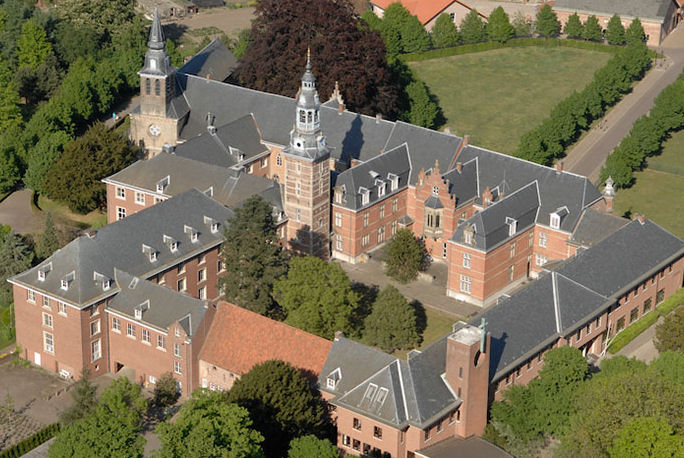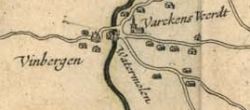Similar to what I did for the previous post on the bunker in Valkenswaard, I'm writing another article where I will tell you about the history behind a building that I built in 3D as a replica. In this post, it's regarding the Venbergse Molen. Molen translates to mill. Take a look at this page to see the 3D scene I made.
The only information we have about the date of when the mill was built is a document dated of 1227. A promise made by the Duke Hendrik I of Brabant that the nearby abbey in Postel would have the rights to receive one third of the mill’s production. Although a mystery, this shows that it must have come into existence in the year 1227. That is quite a long time ago.
In the year 1331 another duke named Jan I of Brabant declared the mill to become a “banmolen”, which means that all the surrounding area farmers were in fact forced to have their grain milled by this specific mill. The promise of one third of the mill production to go to the abbey in Postel remained. Postel is in Belgium just across the border and about 20 kilometers south of the mill. This abbey is quite rich in her own history, but we are not going into that today. The abbey produced a variety of products such as bread and beer, which is still going to this day.
The abbey is quite a tourist attraction now, but back in those days it was quite important for a lot of people living in the surrounding area. They depended on it, and it would have not expanded had the abbey not been there.


Jumping forward in time to the year 1715, when the war against the Spaniards ended after 80 years of fighting, the government of Holland confiscated it. That was not to the liking of the abbey and there were great protests. They even tried to get help from the emperor Karel IV, but to no avail. In the year 1740 the land where the abbey was built was sold. By then, the mill and farm had become one of the most profitable endeavors in the area. It was leased under contracts each three years during quite some time. Later, somewhere in the 18th century the mill was owned by the brothers Jan and Adriaan Snieders, where beer was brewed and became later the very first official brewery of the Netherlands. This was in 1757 and the brewery was called “ Bierbrouwerij Snieders”; it lasted from 1757 until 1860. After that it was called “ Bierbrouwerij De Oranjeboom” from 1860 until 1930. From 1930 until now it is known as “ Dommelsche Bierbrouwerij”. It is still at the same spot, but modernized and with a great industrial output. Dommelsch beer is well known in the Netherlands, but as you may guess, it is more popular in the area. I am quite a big fan of this golden colored, great product.
In the 19th century the mill was owned by several families, such as Verheijen, Thijs, Loos and Van Poppel. In 1918 the Rietra family became the new owners, and they have remained so to this day.
The old Jac Rietra has quite a few interesting stories to tell about this place. One is especially about the time when the Second World War came to an end and the liberation of the Netherlands started. The South of the country was luckier as they were liberated in September 1944, earlier than other parts of the country, while the worst famine occurred, and it had to endure the worst winter ever until it could be liberated, it is still known as the “hunger winter”. While the South was in euphoria, the rest of the country was going through hell. Due to the scarcity of food, the mill went on to work day and night in order to compensate as much as possible. Working in shifts and even on Sunday, the mill had an output of 500 kilograms of flour per hour. The pastor was not amused by this as Sunday was holy, but he had to allow it for the better good. However, as soon as it was not absolutely required, he forbade working on Sunday and threatened with punishment from God. Had it not been for the existence of the Venbergse Molen a lot of people of Valkenswaard and around it would have suffered more cases of starvation during the last year of the Second World War.
As a monument of resilience and strength, the story of the mill came to a dangerous moment when in the 1970s the ground under the mill became unstable. The government did not intend to help or fund its restoration, so father and son Jac Rietra did the work as good as they could by themselves to bring it back to the state it was at the end of the 19th century. The work took a few years, between 1973 and 1977. Later on and due to the good work and history, the mill was declared a national monument, and it is protected, which also implies receiving funds to keep it going as it is now.
The mill is no longer functioning as it was in the past, but it has other means of subsistence. Jac Rietra, the miller, does give it a go once in a while, especially for tourists and other occasions. They have a lovely terrace and bar located alongside the Dommel river, directly next to the mill (no water, no milling). It has become a wonderful place to hang out, have a drink and was a starting and ending point of a boat route on the river Dommel. It has become a tradition for tourists and locals to have a drink at the mill after paddling the river on a canoe.
To every good story comes an end. Other times, other traditions and customs, other wishes and desires. Rietra family has decided to go on with their lives and stop working. Covid period gave them a touch of reality call when they realized that life is not only work (at least 60 to 70 hours a week) but it is also for play. After deliberation in the Summer of 2022 they announced that they had decided to close the place. No successors to continue the work as the younger generations aren’t interested, they retired.
For a lot of people in Valkenswaard, it was a shock. An era has come to an end. Jac Rietra die say that this is not the end of the Mill as it won’t close down completely; he will operate it perhaps as long as he lives so that people will enjoy it.
So there you have it. Hopefully you appreciate this short story on the history of the mill. Now that you know a bit more about the history, it is time to have a look at the 3D scene that I made of it. You can do so here: https://visiestudio.nl/portfolio/venbergse-molen-valkenswaard/